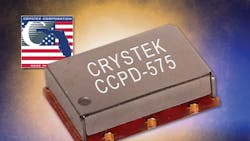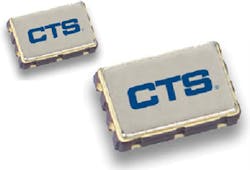Frequency-Control Components Satisfy Demanding Requirements
This file type includes high resolution graphics and schematics when applicable.
Frequency-control components play a key role as they generate frequencies for a wide range of applications. Among the components that can be classified as frequency-control products are crystal oscillators (XOs), voltage-controlled crystal oscillators (VCXOs), temperature-compensated crystal oscillators (TCXOs), oven-controlled crystal oscillators (OCXOs), and voltage-controlled surface-acoustic-wave oscillators (VCSOs). To keep up with industry needs and trends, manufacturers of these components are offering new products with enhanced performance, such as extremely low noise. Their applications include ever-evolving base stations, radar systems, satellite-communication (satcom) systems, test equipment, and many more.
Each type of frequency-control product can be uniquely characterized. An XO can be defined as a non-compensated crystal oscillator. These oscillators can be a viable solution for less stringent stability requirements. For their part, VCXOs typically employ a varactor diode, which enables the oscillation frequency to be varied by applying a tuning voltage.
Temperature stability, which is an oscillator’s frequency variation over temperature, is a very important parameter. TCXOs can achieve temperature stability levels that cannot be achieved by a VCXO, as they usually contain additional circuitry to reduce the frequency variation over temperature.
An OCXO can provide even greater stability than a TCXO. Temperature control is accomplished by means of an oven, enabling OCXOs to offer greater temperature stability than other crystal oscillators. OCXOs are typically used for high-precision frequency applications. Frequency synthesizers, for example, often employ OCXOs as reference oscillators.
Phase noise is an extremely critical parameter for any frequency-control component. To demonstrate an example, frequency synthesizers need to generate clean outputs for modern communication systems, thereby requiring low phase noise. The phase noise of a synthesizer is often related to the phase-noise performance of a lower-frequency reference oscillator, such as an OCXO. This is only one example that demonstrates why it is essential for suppliers of frequency-control components to deliver products with low phase noise.
The Latest XOs, VCXOs, TCXOs, and OCXOs
XOs are available with various types of output logic, such as HCMOS, LVPECL, and LVDS. Their applications include Ethernet, SONET, and many others. One product that was recently released is the CCPD-575 from Crystek (Fig. 1). “Crystek has seen an increase in demand for crystal oscillators with less than 100 fs of root-mean-square (RMS) phase jitter (12 kHz to 20 MHz),” says Ramon Cerda, VP of Engineering at Crystek. “This requirement cannot be achieved with any present form of phase-locked loop (PLL) multiplication. Hence, fundamental or overtone oscillators must be used to meet this challenge. At the 12-kHz offset, the phase noise of the oscillator is near its noise floor. Hence, reducing the noise floor is a key factor in order to obtain jitter below 100 fs.”
As a result of the new performance achievements, the company is enabling applications like digital video, SONET, storage area networks, and Gigabit Ethernet. Cerda adds: “The noise floor of an LVPECL oscillator is directly related to the LVPECL buffer. All of our new LVPECL oscillators use a new generation of LVPECL drivers that have a noise floor of approximately -160 dBc/Hz. Traditional legacy drivers have a noise floor of -145 dBc/Hz, so a 15-dB improvement is achieved.”
Another supplier of frequency-control components is CTS Electronic Components. The company offers a range of products, such as VCXOs, TCXOs, OCXOs, VCSOs, and more (Fig. 2). Some of their latest products offer a simplified solution for applications like wireless infrastructure. These components also provide low phase noise at higher frequencies. “Our new high-frequency fundamental output VCXOs simplify the clock-generation design engineering effort needed in both wireless infrastructure and core networking systems,” says Roger Merel, director of technical marketing & business development at CTS Electronic Components. “They assure specification compliance without needing factory adjustments. Concerns about lot-to-lot component tolerance variations are also eliminated. In addition, customers are relieved of the difficulties associated with sourcing custom pull-able crystals and meeting absolute pull range.”
Merel adds: “These VCXOs are easy to use in a PLL. They can be used to scale up the clock rate from the master oscillator to frequencies that range from 100 to 250 MHz. This includes popular rates, such as 100.0, 122.88, 125.0, 153.6, 155.52, 156.25, 166.0, 200.0, 204.8, and 245.76 MHz. The phase noise is kept extremely low at these high frequencies. At 122.88 MHz, for example, typical phase noise is -155 dBc/Hz at 100-kHz offset.”
Low-phase noise components are being developed to provide solutions for application requirements. For example, the need for quieter frequency references is prompting suppliers to deliver components that offer lower phase noise. The XO5123-series OCXOs from MtronPTI can satisfy these demands, as they are intended to meet the needs of increasing Internet bandwidth. The 10-MHz XO5123 has a phase noise of -146 dBc/Hz at 10-Hz offset. In addition, its phase noise is -172 dBc/Hz at higher offset frequencies. Additional suppliers of OCXOs include Wenzel, Bliley, Connor-Winfield, Golledge Electronics, Fox Electronics, and IQD Frequency Products, to name a few.
One recently released low-noise TCXO is Vectron’s VT-706 model. It is available with output frequencies ranging from 5 to 52 MHz. In addition to its low noise performance, the VT-706 can achieve temperature stability as low as ±0.05ppm. This report provided a very small sample of the many components on the market today. Numerous products are currently available to satisfy the large number of applications requiring frequency-control products. It is clearly demonstrated that low phase noise is crucial for today’s environments. For those who wish to learn more, Vectron, Crystek, Wenzel, and IQD Frequency Products are some examples of companies that provide a collection of helpful application notes and tutorials. These can be a valuable resource for those who need to acquire more in-depth knowledge about frequency-control components.
This file type includes high resolution graphics and schematics when applicable.



